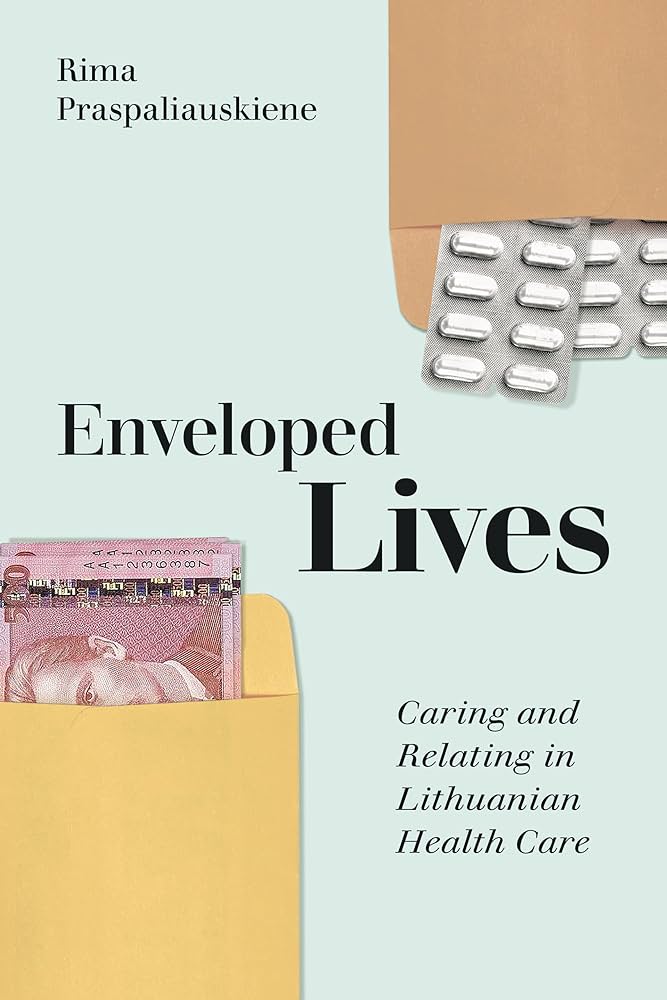Reviewed Book
Enveloped Lives: Caring and Relating in Lithuanian Health Care By Rima Praspaliauskiene, Ithaca, NY: Cornell University Press. 2022. 146 pp.

Michelle Anne Parsons
Northern Arizona University
Rima Praspaliauskiene’s Enveloped Lives offers a lucid and focused exploration of the practice of giving envelopes (vokelis) of informal cash payments to medical providers in Lithuania even in a neoliberal era when global and governmental institutions often condemn the practice as bribery or a remnant of the socialist past. Praspaliauskiene treats giving envelopes as a relational practice which she calls “enveloped care.” The envelope represents a persistent desire to be recognized and treated as a singular person rather than a standardized customer. Envelopes are an “affective (bio)metrics” that allows patients, not without anxiety or ambivalence, to place particular value on the experience of care. The book is an important contribution to the anthropology of exchange and related concepts of gifts, recognition, and the monetization of social relations. It brings these themes into generative conversation with the medical anthropology of magic, belief, healing, and the medical encounter.
The ethnography is primarily based on 18 months of fieldwork at a public hospital in Vilnius in 2009 and 2010 during a period of financial crisis and healthcare reform. Praspaliauskiene also conducted archival research and interviews with patients, relatives, doctors, staff at Transparency International Lithuania (TIL), and officials at the Ministry of Health (MOH), in addition to making a number of follow-up visits in which she shared findings with her interlocuters.
The book is organized into four body chapters and three interludes which each convey a canonical story of gifts given to doctors. An epilogue explores how introduction of the euro in 2015 and new campaigns against corruption have affected envelopes. The first chapter historicizes the envelope in pre-Soviet and Soviet history. After Lithuania became a member of the European Union in 2004, TIL and a neoliberal think tank, Free Market Institute, mounted campaigns against the practice as untransparent and irrational, a relic of Soviet times and a form of corruption. Informal gifts were seen as an impediment to the privatization of healthcare and official co-payments. As a relational practice, however, the envelope does not represent payment as much as a relationship; it is part of a human, not market, economy. The second chapter develops the theme of patients and providers “being caught” in the relations of the envelope. For some patients, the envelope may be a part of coping, hoping, and healing. The amount of money and its presentation is a complex social negotiation involving friends and family. Others feel provoked by providers to give; yet others, who do not want to give, may have family members who insist on giving. Through these examples, the reader understands the envelope as a relational and collective practice. In chapter three, ambivalent doctors develop personal ethical codes to manage envelopes and their corrupting potential. Envelopes may subtly challenge medical authority, when patients give money and then expect certain tests or medications, or humanize it, when patients then expect doctors to be more attentive and spend more time listening to their stories. At the same time, doctors often view envelopes as evidence of being a good doctor. The envelope informs ethical perspectives on good and bad doctors, working conditions, healthcare reform, and the commodification of care. The last chapter explores the entanglement of envelopes in larger “caring collectives” which have sustained Lithuanian society through its turbulent history by prioritizing interdependency and kinship.
This book is extraordinary in its tight focus on one healthcare practice in Lithuania, tracing the envelope through history, examining it from multiple perspectives, and situating it in larger processes of healthcare reform and collective care. Praspaliauskiene does not fall into the trap of considering gifts and bribes as distinct categories, but rather potential elements (among others) of the envelope which emerge relationally in unstable assemblages. One of Praspaliauskiene’s most important contributions is to show how the envelope is a precapitalist economic form which continues to assert the primacy of social relationships and a “collective will to care” amid the forces of market capitalism. In this way, the envelope reveals gaps in institutionalized medicine far beyond Lithuania, where patients and providers often yearn for medical encounters that emerge from singular, as opposed to standardized, relationships of care embedded in yet other caring collectives—“enveloped care.”
Praspaliauskiene’s eminently readable book makes contributions to the anthropology of economy and exchange, the anthropology of postsocialism, and the medical anthropology of care and the medical encounter. The book will be of interest to scholars and students of postsocialist healthcare, healthcare reform, and healing. It is appropriate for advanced undergraduate and graduate students.